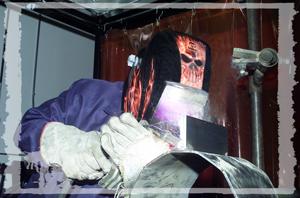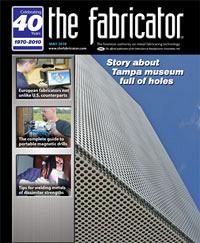Contributing Writer
- FMA
- The Fabricator
- FABTECH
- Canadian Metalworking
Categories
- Additive Manufacturing
- Aluminum Welding
- Arc Welding
- Assembly and Joining
- Automation and Robotics
- Bending and Forming
- Consumables
- Cutting and Weld Prep
- Electric Vehicles
- En Español
- Finishing
- Hydroforming
- Laser Cutting
- Laser Welding
- Machining
- Manufacturing Software
- Materials Handling
- Metals/Materials
- Oxyfuel Cutting
- Plasma Cutting
- Power Tools
- Punching and Other Holemaking
- Roll Forming
- Safety
- Sawing
- Shearing
- Shop Management
- Testing and Measuring
- Tube and Pipe Fabrication
- Tube and Pipe Production
- Waterjet Cutting
Industry Directory
Webcasts
Podcasts
FAB 40
Advertise
Subscribe
Account Login
Search
Welding metals of dissimilar strengths
Successfully welding such material requires the right filler metal and joint design
- By Dean C. Phillips
- April 30, 2010
- Article
- Arc Welding
In an ideal world all metals would match perfectly, both in their mechanical and chemical composition. It would certainly simplify welding, especially when selecting filler metals. Yet in many applications it is necessary to weld materials with different strengths. By doing so you can reduce material costs and use metals that are better-suited to the end-service conditions of the completed component.
Beyond just using the correct filler metal, successfully welding dissimilar-strength steels requires close attention to a few other factors. You must know the weldability of the materials to be joined; assess the service condition to which the parts will be subjected; and use the correct welding, preheat, and interpass temperatures for the application.
Making a Good Match
In most cases, you should match the tensile strength of the filler metal and the lower-strength material as closely as possible. Doing so offers the least potential for cracking. For example, when welding A514—a minimum 110-KSI tensile, low-alloy, quench-and-tempered steel—to A36 steel with a minimum 58-KSI tensile strength, choose a filler that more closely matches the A36 base metal, such as a filler metal with 70-KSI tensile, the lowest strength typically available on the market.
Certain joint designs may allow you to undermatch the filler metal’s strength to the lower-strength material. For instance, some fillet joints created by joining a 100-KSI yield, quench-and-tempered material like A514 to an even higher-strength, proprietary high-strength, low-alloy 130 material can accommodate welds with 70-KSI filler metals. Despite the lower-strength weld metal, the joint design in this situation still provides adequate overall strength for the application. You always should consult the welding specifications to determine whether undermatching the filler metal is appropriate.
Overmatching filler metal strength is generally not recommended. It can create a notch effect, resulting in too much stress in the lower-strength side of the weldment and weld interface. This could lead to failure that typically occurs at the weld toe.
Weldability
Weldability refers to the general ability of two materials to be joined successfully without defects like cracking from material chemistry issues, while also obtaining the mechanical properties necessary for the application. Weldability varies from material to material and often depends on other criteria, such as the joint configuration and the service conditions the final weldment will encounter.
Determining weldabilty helps establish how easily dissimilar materials can be welded, as well as which welding process and filler metal are most appropriate for the job. And it also helps determine how suitable the materials are for the application. For example, if welded components will be under a cyclic load, the two dissimilar-strength materials and the deposited weld metal must be compatible for fatigue life.
Part of determining weldability is calculating the carbon equivalency (CE) of the base materials, often using the following CE formula: CE = C + (Mn + Si) / 6 + (Cr + Mo + V) / 5 + (N i+ Cu) / 15. The CE helps you determine cracking susceptibility as well as the necessary preheat and interpass temperature controls.
To determine weldability, you need to know the chemistry of the two dissimilar-strength base metals, as it is probable (but not absolute) that they will have different chemical compositions. A material’s weldability may be identified by ASTM, ASME, AISI, SAE, or similar standards. Some standards specify the chemistry properties required for certain material grades; other standards give mechanical property requirements; and some standards give both. For instance, you may need to weld ASTM A572 Grade 50 to AISI/SAE 4140, in which the former material has both chemistry and mechanical requirements, but the latter has only a chemistry requirement.
Most important, determining the weldability helps you assess how susceptible materials are to problems like hydrogen cracking so you can take the necessary precautions against them, such as selecting low-hydrogen filler metals or applying an appropriate preheat, interpass temperature, and, if required, postweld heat treatment (PWHT). A good reference here is Weldability of Steels by Robert D. Stout and W. D’Orville Doty, published by the Welding Research Council.
Service Conditions
When welding dissimilar metals, you need to consider the final service condition that the weldment will encounter. In certain applications, you may weld dissimilar-strength materials to create components that will encounter high temperatures. For instance, you may need to weld ASTM A387 chrome-moly steel tubes—for a high-temperature, corrosion-resistant boiler application—to a transition piece of A36 steel that will not encounter the same temperatures.
In this situation, the chrome-moly may have a yield strength around 60 KSI and a tensile strength of 80 KSI; the A36 steel has a 36-KSI yield strength. Not only do you need to select a filler metal that matches the lower-strength material, but you also may need to find a filler metal capable of being stress-relieved. High-temperature materials (in this case, the chrome-moly portion) typically don’t require the toughness brought forth by stress-relieving. But because this application uses A36 steel, the weld and A36 base metal may still require PWHT depending on the design application.
Dissimilar materials subject to highly abrasive service conditions also require special attention. In construction equipment applications, companies often protect their heavy equipment from day-to-day wear by welding abrasion-resistant (AR) plates to components such as bulldozer blades and backhoe buckets. Unfortunately, welding AR plate to softer or lower-strength steels (usually A36 or A572) brings with it the potential for cracking in the heat-affected zone (HAZ) of the AR plate. Here, you need to use a joint design such as a short, small fillet weld that can reduce heat input and overall residual stresses on the AR plate, and also find a filler metal that resists cracking.
As a rule when welding higher-strength and less ductile metal to lower-strength material, using the proper preheat and interpass temperature controls, as well as undermatched filler metals with low diffusible hydrogen levels, offers the least potential for cracking. Of course, every welding application is different. You must consider the end-service conditions, such as heat and abrasion, to determine which filler metals and joint designs can best accommodate the differences in material strengths.
Preheat, Interpass and PWHT Requirements
Joints created between dissimilar-strength materials sometimes can be used in the as-welded condition, meaning the final weldment is acceptable for service after passing inspection, with no PWHT required. This happens because matching the filler metal to the lower-strength base metal provides adequate strength in the final weldment. Other applications, however, may need to be stress relieved.
To stress-relieve a weld, you heat the base and weld metals per a time/temperature schedule that varies according to the application. You hold the material at that temperature, then ramp down slowly to cool the metal evenly. The process reduces the weld’s residual stresses that could lead to premature failure from creep rupture, fatigue, or cracking. And, of course, you must select a filler metal that can withstand this stress-relieving process. You will also need to consider how such stress-relief affects material properties. Some steels, such as quenched-and-tempered material, can lose their mechanical properties when stress-relieved at elevated temperatures.
In some cases, preheat and interpass temperature requirements may even call for a requalification of the welding procedure. For example, you may need to weld two dissimilar-strength materials that require different preheat and interpass temperature controls.
Consider a joint comprised of ASTM A514 steel that requires a 225-degree-F preheat and AISI/SAE 4140 steel that requires 600-degree preheat. Following the more stringent requirement (the 600-degree preheat) could prevent problems such as cracking, but it may also affect the integrity of the A514 steel. Instead, you may want to compromise between the two preheat requirements, perhaps by choosing a 350-degree preheat. In critical applications, you may need to requalify the welding procedures to ensure that such a compromise still provides adequate strength and mechanical properties.
New Weld, Same Fundamentals
Ensuring a joint has adequate strength and meets the application’s mechanical requirements is, of course, fundamental to all welding. So while it can require high skill and an even greater knowledge to weld dissimilar-strength carbon and low-alloy steels, the process doesn’t have to be overwhelming. If you consider a few basic factors and select the correct filler metals for the application, you can significantly improve your chances of success.
About the Author
Dean C. Phillips
101 Trade Square
Troy, OH 45373
937-332-4000
Related Companies
subscribe now

The Fabricator is North America's leading magazine for the metal forming and fabricating industry. The magazine delivers the news, technical articles, and case histories that enable fabricators to do their jobs more efficiently. The Fabricator has served the industry since 1970.
start your free subscription- Stay connected from anywhere

Easily access valuable industry resources now with full access to the digital edition of The Fabricator.

Easily access valuable industry resources now with full access to the digital edition of The Welder.

Easily access valuable industry resources now with full access to the digital edition of The Tube and Pipe Journal.
- Podcasting
- Podcast:
- The Fabricator Podcast
- Published:
- 04/16/2024
- Running Time:
- 63:29
In this episode of The Fabricator Podcast, Caleb Chamberlain, co-founder and CEO of OSH Cut, discusses his company’s...
- Industry Events
16th Annual Safety Conference
- April 30 - May 1, 2024
- Elgin,
Pipe and Tube Conference
- May 21 - 22, 2024
- Omaha, NE
World-Class Roll Forming Workshop
- June 5 - 6, 2024
- Louisville, KY
Advanced Laser Application Workshop
- June 25 - 27, 2024
- Novi, MI
































